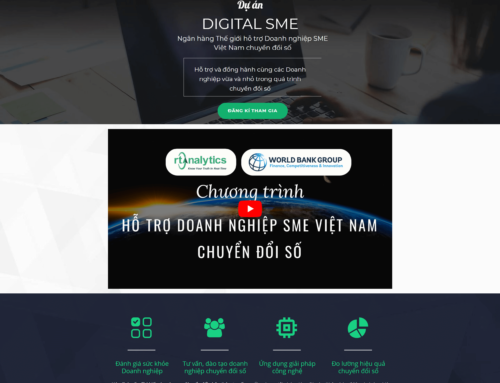Project Description
The evolving Covid-19 situation has caused most businesses to switch to remote work to keep employees and customers safe. Although this model helps to alleviate anxiety about potential exposure to Covid-19, save office operation costs, cut down commuting time and eliminate office gossip, many business leaders are still concerned about efficiency when allowing employees to work from home (WFH). This article will share tips to help businesses use this model effectively.
1. Establish daily goals and reporting procedures
When teleworking, there are many potential disruptions that can break employees’ focus, such as looking after the kids or other housekeeping items. Establish clear goals for each project; ask each team and each employee to proactively plan their daily tasks and set goals to ensure project progress. This will help employees be proactive in completing their tasks and not be distracted when working from home.
To do this effectively, instead of using normal tools like email or social network sites, provide your employees with professional work management tools, so they can sign up for tasks, check in before their shift starts, check out after their shift ends and report their work progress every day. Requiring checking in before starting the work day, including a selfie of the employee “at work,” will help to establish a positive work attitude and readiness for the shift.
This WFH model gears the company more towards “hands-off” management without the need for manual supervision while also ensuring that the employees are getting their work done. Each employee will know what their duties and responsibilities are, and management can proactively monitor overall team performance.
2. Keep in contact and stay online
Set a fixed team meeting schedule at the start of each day to assign tasks, address problems, and ensure smooth communication between each team and employee.
Select a tool for online internal communication and provide employees with access to that tool so everyone can be connected and ready to discuss when needed. That tool needs to have one-on-one chat, group chat and video call capabilities, which will enable employees to hear and see their fellow colleagues and create the sense that they are still working together in the office.
Businesses should avoid using chat and video call features on personal social media accounts (such as Facebook, Zalo, Viber, etc.) for work because these platforms are very distracting for employees and could result in accidental exposure of classified company information. Use a separate communication tool that is dedicated to work and where admins can quickly close account access when employees no longer work for the company.
3. Focus on communication
Communication is extremely important in the process of carrying out work tasks. Sometimes you may encounter communication issues when working in the office, such as misunderstanding the other person’s intentions or unnecessary friction between two parties. When working from home, miscommunication may be amplified and is more likely to occur. Therefore, focus on making sure each team understands the leader and each employee understands each other.
Create opportunities for people to communicate with each other more often and share information with others, such as work progress and problems encountered. Aside from talking about work, managers can also encourage teams to share personal stories to increase engagement and understanding. At this time, a tool that can both ensure the work can be accomplished and smooth communication is very necessary.
4. Set clear guidelines for rewards and penalties:
No matter where your employees work, maintaining discipline is extremely important, especially when it is more difficult to manage remote work outside of the office. Therefore, set rules for WFH and set reward and penalty policies for all team members so it is clear what their responsibilities and limits are when working remotely. Rewards and penalties executed at the right times and in the right places will motivate employees to work well.
To assist with this, use a tool that helps set clear, flexible and transparent reward and penalty scenarios, and can run automatically to optimize HR’s time and effort spent monitoring while still ensuring accuracy and efficiency.
5. Equip your employees with effective remote working tools
This is the most important factor to ensure effective remote business management operations. To accomplish the four factors above, businesses need to set up a system with remote working tools, which can include devices and softwares that help manage tasks remotely (assigning jobs, reporting, analyzing work progress, task reminders, etc.); manage human resources remotely (remote check in and check out with GPS coordinates; request days off, overtime, approval, etc.); manage customer data, interactions, sales; maintain communication and meeting platforms like chat and video calls, etc.
Currently, there are many free tools to support the above features:
- Online meeting: Google Hangouts, Zoom, Skype, Viber, Zalo
- Project management: Trello, Asana, Todoist
- Customer relationship management: Sheet, Pipedrive
With the softwares above, companies need to note two major disadvantages:
- Employees using personal accounts for work can lead to the possibility of leaked company information and distraction during working hours
- Companies have to provide access to the right technological tools in order for employees to get their work done.
These two major disadvantages can be completely overcome by using rtWork, a business operations management software. Businesses can quickly deploy rtWork to operate paperlessly with a full range of tools in one software (HR, CRM, assign tasks, internal communication, telecommunication services, customer service, sales/revenue and expenditure management, supervision approval, etc.).
In particular, businesses do not need to invest in upgrading technological infrastructure or bring on IT specialists because rtWork can easily be used on existing computers and mobile devices, and does not require any special devices.
You can try out our technological solution here:
https://rtlink.me/rtwork-vndemo
If you would like more information or support, please contact:
- Mr. Trung Le, PhD, CEO
- Email: trungle@rta.vn
- Phone: 0866224858, Ext: 5001
We hope you will use these secrets to successfully manage your business to overcome the challenges that Covid-19 brings!




